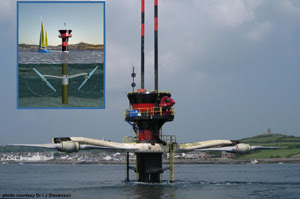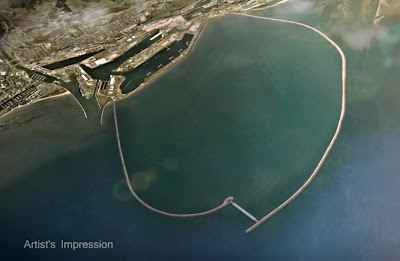Tidal energy represents a significant power source, with one estimate of the addressable market being upwards of 3 TeraWatts, according to the IEA. This corresponds to 60% of the world's currently installed electricity generating capacity of 5.066 TeraWatts. The level of investment in advanced tidal energy technologies has increased significantly in the past decade, with scale deployments of new technologies currently underway. There are three major types of tidal power, each with different market sizes, technologies and levels of maturity.
Tidal Barrages
Tidal barrages are the most mature tidal technology, with three major installations around the world with more in the planning stage. These include the oldest installation, the 240 MW installation in Rance, France; the 17.8 MW Annapolis Royal Generating Station in Annapolis Royal, Canada; and the recently opened 254 MW Sihwa Lake Tidal Power Plant in South Korea.
 The Rance tidal barrage, also known as La Rance Power Station, is located in Brittany, France. The 240 MW installation was completed in 1967 and has several unique features. It serves as a causeway across the Rance estuary, significantly shortening the drive time along the French coast, between Dinard and St. Malo. In order to preserve boat access to the inland side of the barrage, a lock system was installed, along with a swing bridge for the roadway. The plant has 24 turbines, and produces approximately 600 GWh per year. Although the original cost to construct the facility was high, it has since been paid for, and the current marginal cost is less than that of nuclear power. The tidal flow in that section of France is approximately 8 meters, which is helpful for tidal power production. .
The Rance tidal barrage, also known as La Rance Power Station, is located in Brittany, France. The 240 MW installation was completed in 1967 and has several unique features. It serves as a causeway across the Rance estuary, significantly shortening the drive time along the French coast, between Dinard and St. Malo. In order to preserve boat access to the inland side of the barrage, a lock system was installed, along with a swing bridge for the roadway. The plant has 24 turbines, and produces approximately 600 GWh per year. Although the original cost to construct the facility was high, it has since been paid for, and the current marginal cost is less than that of nuclear power. The tidal flow in that section of France is approximately 8 meters, which is helpful for tidal power production. . The 17.8 MW Annapolis Royal Generating Station is located at the mouth of the Annapolis River on the Bay of Fundy, Nova Scotia, Canada. It was built over a four year period, and commissioned in 1984. There are some unique features associated with the facility. First off, it produces power only on the outgoing tide, allowing the head water basin to fill on the incoming tide, and then producing power over a five hour period on the outgoing tide. This cycle is repeated roughly twice per day, and produces approximately 80-100 MWhrs per day, depending on the ties. The tides in the Bay of Fundy average 12 meters, and can be as high as 16 meters. At the location of the Annapolis station average 7.5 meters, and can rise as high as 12 meters.
The Annapolis station uses a single-effect turbine, meaning that it generates power flowing in only one direction. The La Rance station, on the other hand, utilizes a double effect turbine, allowing for the extraction of power on both the incoming and outgoing tides. It has been best determined that double effect turbines require a higher head than single effect turbines. For the Annapolis station, it generates power upon conditions where there is at least a 1.6 meter differential between the head pond and sea level. The Annapolis turbine is quite large, with a 3 meter diameter.
Tidal Current
Tidal current systems are either horizontal axis two and three bladed turbines or vertical axis type turbine designs, known as axial turbines, positioned horizontally. Tidal current systems are typically secured to or positioned on the sea floor in arrays. These systems are just now emerging, with two designs having completed scale deployments and are taking commercial orders. The two most mature designs include the 1.2 MW SeaGen system in Strangford Lough in Northern Ireland; and the 180 kW TidGen deployment in Cobscook Bay, near Eastport, Maine.
The 1.2 MW SeaGen system in Strangford Lough in Northern Ireland was deployed in 2008, and has been in operation and under extensive testing since that time. The design is a monopole support, anchored to the sea floor, with a horizontal strut that supports two horizontal axis rotors at opposite ends. The rotors themselves have the highest weep area of any deployed system, of 402 square meters for the pair of rotors. Each rotor is 16 meters in diameter and spins at 14 rpm.
The system cost $18.36 million. The cross beam is designed to be raised and lowered to facilitate maintenance. The system is at the mouth of the Strangford Lough, or Loch, Southwest of Belfast, which encompasses 105 square kilometers of water, one of the largest coastal bays. The system produces up to 6,000 MWhrs per year, according to the company’s web site, corresponding to a 57% capacity factor, which is much higher than wind or solar.
The pitch of the blades can be adjusted up to 180 degrees, allowing for bidirectional flow and energy capture. Additionally, the blades are purposefully located in the top third of the water column, where the greatest water flow is found.
The company which manufactured the system is taking its experience and developing a 2 MW system for commercial deployment, with 20 meter diameter blades in a similar configuration. They are also planning a 3 MW system that is deployed in deeper waters, where the surface is not pierced by the system. The 3 MW design is in the very early stages of design at this time.
The 180 kW TidGen tidal generating system was deployed in Cobscook Bay, near Eastport, Maine, in August, 2012. The turbines are axial turbines, utilizing a blade design that appears to be similar to the twisting of DNA strands, with the axis horizontal and perpendicular to the flow of the water. The TidGen system utilizes a blade structure that is 98 feet long and 16 feet high in cross section. The system is designed to produce 180 kW at rated output, and plans are in place to increase the number of turbine systems deployed to produce 5 MW, requiring, as it appears, the deployment of 28 TidGen systems.
Tidal Lagoons
Tidal lagoons are large shallow areas defined by perimeter barriers, with a sluice way with turbines to generate power. There are no tidal lagoons currently built, although there are two major designs on the drawing board. One is the proposed 250 MW Swansea tidal lagoon in Swansea, UK. The other is the 300 MW near the mouth of the Yalu River in China. Tidal lagoons are expensive to build, but have higher capacity factors, of about 62%.
The proposed 250 MW Swansea tidal lagoon is an ambitious project proposed in Swansea England. The system relies on approximately 7 miles of barrages to be built, to create the lagoon. The expected cost of the project is $841 million. The system is designed to generate power on both the incoming and outgoing tides, estimated to operate for 16 hours per day.



No comments:
Post a Comment